Looking to visit some UNESCO World Heritage sites in Europe? In this post, I cover 50+ of the top sites you should visit.
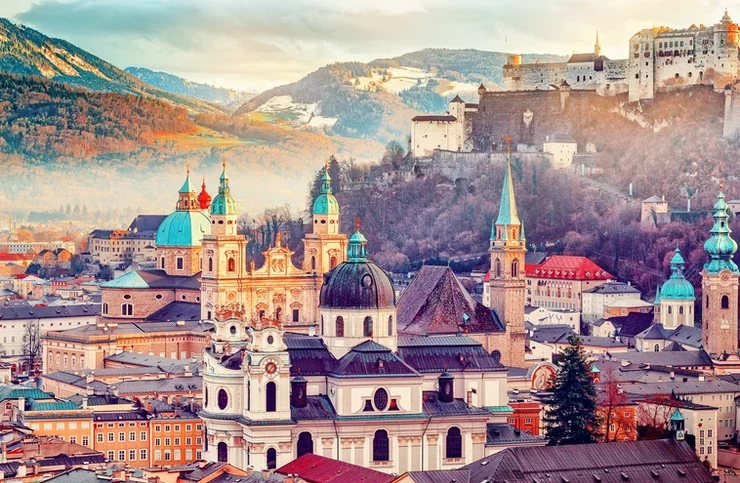
These UNESCO sites are among the most famous landmarks, monuments, and attractions in Europe. From towering castles to opulent palaces, these European landmarks are among the best things to do and see in Europe.
UNESCO sites reflect humanity’s legacy. They’re highly significant cultural or natural sites that are our historic touchstones, that reflect our identity, or can catapult us back in the past to important events.
Once inscribed on the UNESCO list, these sites are protected and conserved.
In this guide, I focus on the cultural landmarks, taking you to important monuments and architecture in Europe.
I’ve picked the 55 best UNESCO sites in Europe, to help you create your own Europe bucket list or itinerary. They’re some of the world’s most amazing destinations and places to explore.
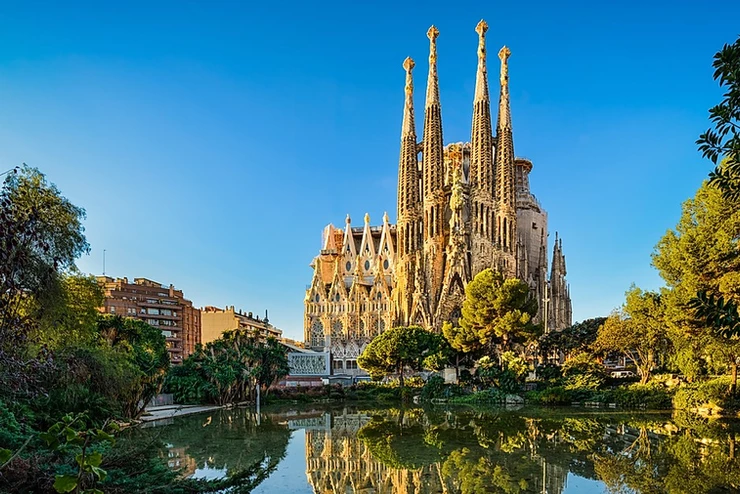
The Best UNESCO Sites In Europe: Spain
1. Sagrada Familia, Barcelona
The undisputed jewel of Barcelona is Sagrada Família, Gaudí’s wildly creative opus. Gaudí began work on the “Sandcastle Cathedral” at age 31. In rather megalomaniac fashion, it’s supposed to constitute a complete history of the Catholic faith.
The exterior looks like a mountain of sand. But the interior is luminous. It’s effectively a sculpture, reinvented as architecture. The nave is lined with pale columns. They look like a forest, with columns branching out like trees.
It’s absolutely essential to book a skip the line ticket for Sagrada Familia. I also recommend booking a 2 hour skip the line private tour.
Sagrada Familia has opened its digital doors and now provides an extensive virtual tour right on its website. You can visit the Passsion Facade, the Nativity Facade, the interior, the apse, the Cloister of the Rosary, the Western Sacristy, the Crypt, and Gaudi’s Tomb.
You can also take a 360 tour on Air Pano. Smarthistory has a great YouTube video about the Sagrada Familia.
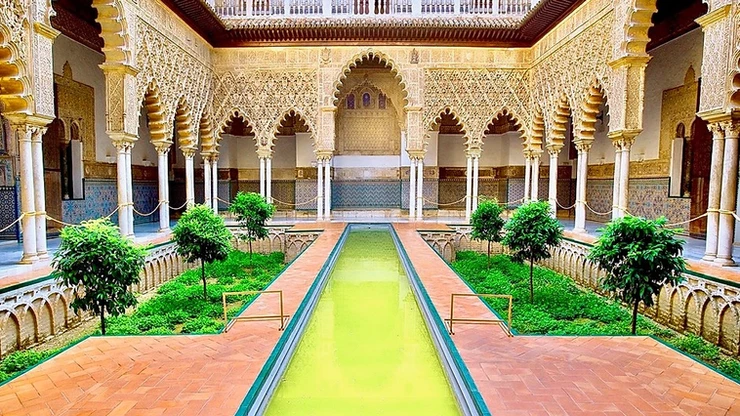
2. The Royal Alcazar, Seville
The Royal Alcázar is one of the world’s greatest cultural treasures and one of the best UNESCO site sin Europe.
It’s a centuries old complex of palaces and fortifications, lovely courtyards, and extensive gardens bursting with orange, purple, and green colors. It’s a breathtaking 10th century palace that King Pedro the Cruel gave a 14th century Mudéjar facelift.
Inside, the highlights are the Hall of the Ambassadors, the Courtyard of the Maidens, the Courtyard of the Dolls, and the Hall of Tapestries in the Gothic Palace.
The Ambassador’s Hall, or Throne Room, is the big showstopper. It’s nicknamed the “Half Orange” Room, in honor of its gilded cedar domed ceiling.
Here’s my complete guide to visiting the Royal Alcazar. To avoid waiting in long lines, you’ll need to book a skip the line or skip the lane guided tour.
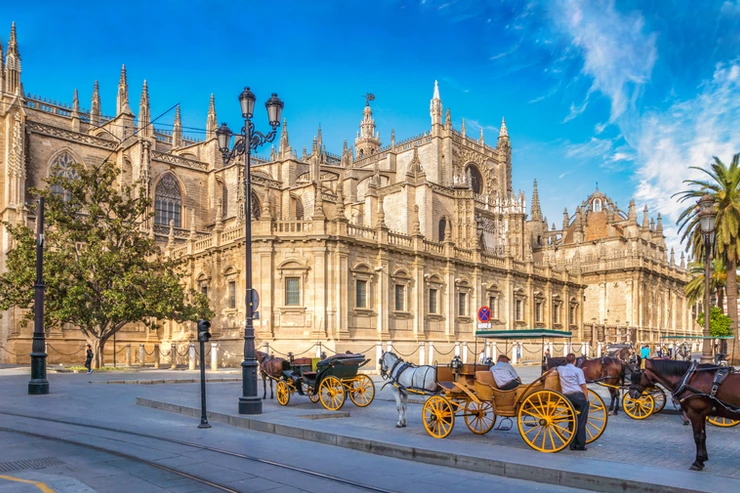
3. Seville Cathedral, Seville
Seville Cathedral stands as an imposing masterpiece of Gothic architecture, holding the distinction of being the world’s largest cathedral. A visit to this monumental attraction is an absolute must when exploring Seville’s rich heritage.
The cathedral’s history traces back to 1402, a pivotal moment following the Reconquista when King Ferdinand and Queen Isabella commenced the construction of a grandiose Gothic cathedral. Their aim was to create a magnificent showcase of Seville’s opulence, influence, and prominence.
The cathedral’s facades boast an impressive array of 15 distinct doors, each adorned with intricate reliefs and carvings that narrate stories of art and history. Within its cavernous interior, the cathedral’s nave stretches forth as the longest in the world, a testament to both its grandeur and architectural innovation.
One can’t help but be dazzled by the resplendent altar, a work of intricate detailing adorned with lavish gold leaf. Exploring along the sides of the cathedral reveals a captivating collection of 80 chapels, each with its own unique story waiting to be discovered.
>>> Click here to book a skip the line ticket

4. The Alhambra, Granada
The Alhambra is the world’s last and greatest Moorish fortress. It’s one of the most visited UNESCO sites in Spain, and even in the world. The Alhambra sits on a stunning piece of real estate – a high, mountainous location on Sabika Hill with sweeping views over Granada.
The complex has four must see sites: the Nasrid Palace, Charle V’s Palace, the Alcazaba, and the Generalife Gardens.
The Nasrid Palace is the finest example of the refined, intricate, and elegant architectural style of the Moorish civilization. Every inch of its rooms are decorated, top to bottom, with ceramic tiles, elaborate plaster work, calligraphy, filigreed windows, and stucco stalactite ceilings.
You can take a virtual tour of the Alhambra on Google Arts & Culture. The official Alhambra website offers an impressive 3D virtual tour of the entire site.
Here’s my complete guide to the Alhambra. This is one place you can’t visit without a skip the line ticket or skip the line guided tour booked weeks in advance.
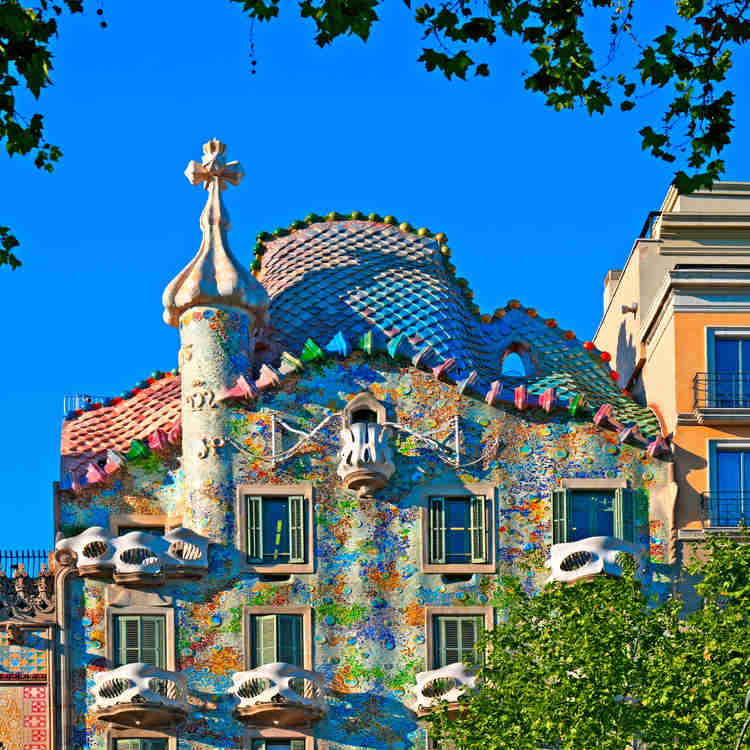
5. Works of Antoni Gaudí, Barcelona
Barcelona’s most famous son, Antoni Gaudí, left a massive legacy in Barcelona. In the late 19th and early 20th century, he created some of the world’s most beautiful, unique, and innovative buildings. With perpetually curving lines and colorful mosaics, he launched Catalan Modernism, an art nouveau style.
Seven of Gaudi’s creations in Barcelona are designated UNESCO World Heritage Sites, including: Park Güell, Palau Güell, Casa Mila, Casa Vicens, Gaudi’s work on the Nativity facade and crypt of La Sagrada Familia (mentioned above), Casa Batlló, and the Crypt in Colonia Güell. I’ve added links to the ones you can tour virtually.
Here are my own comprehensive guides to: Gaudi architecture in Barcelona, Casa Battlo, Casa Mila, and Casa Vicens. If you’re a Gaudi fanatic like me, you may also like my guides to Gaudi’s Casa Calvet and El Capricho buildings.
You’ll need to book a skip the line ticket for Casa Battlo and a ticket for Casa Mila.

6. Palau de la Musica, Barcelona
Palau de la Musica Catalana is a gaudy rose-covered wonderland and one of Barcelona’s must visit landmarks. Domenico Montaner designed this magnificent concert hall in 1905-08.
You have to see it to believe it. Musicians love its acoustics. Tourists love its unique design. It’s a veritable symphony of stained glass, mosaics, and sculptures.
You begin at the marble Lluis Millet Grand Staircase, named after a famous Catalan composer. As you ascend, gaze up at the eye catching ceramic glazed ceiling.
The auditorium is almost overwhelming. The piece de resistance is the intricate stained glass sun by Antoni Rigalt. It seems to float in midair from the ceiling’s inverted dome.
Iron and glass chandeliers create a starry night effect. And sculptures curve up the sides of the stage, including a glowering Beethoven and Valkeries from Richard Wagner’s operas.
READ: Guide To Barcelona’s Gothic Quarter

7. Cathedral of Santiago de Compostela, Galicia
The Cathedral Santiago de Compostela stands guard in the Plaza do Obradoiro square, where all roads in Santiago converge. This hallowed Galician landmark in northern Spain is the final stop on the mystical pilgrims’ journey.
Built in the Romanesque architectural style, construction started in 1075 during the reign of Alfonso VI. Over the years, Gothic, Baroque, and Neoclassical elements were added to the structure.
The Cathedral’s facade is the work of Fernando de Casas y Novoa. It’s a splendid example of Spanish Baroque design.
Atop the middle steeple, St. James the apostle stands on a column to welcome pilgrims to his burial place. The Portico of Glory at the main entrance used to be the cathedral’s main facade. It displays 200 figurines from the Old and New Testament.
Inside, a darkened Romanesque nave gives way to a large gold altar with three representations of St. James. Pick up an audio guide because there’s not much English signage. Click here for a virtual tour.

8. Palaeolithic Cave Art of Altamira, Cantabria
This is the most ancient site on my list. Over 35,000 years ago, our ancestors painted images of animals on the walls of a cave in Altamira, in northern Spain.
They were created during the Upper Palaeolithic period. The well preserved charcoal and polychrome paintings depict animals and handprints in varying colors.
The ceiling of the cave features the paintings of a herd of now-extinct steppe bison, as well as deer, wild boar, and horses. Access is strictly limited to small private tours.
You can take a virtual tour of the Altamira caves here. You can also book a guided tour of Santillana Del Mar and the Altamira Museum.

9. Mosque-Cathedral of Córdoba, Cordoba
Originating in the 10th century, Cordoba’s Mosque-Cathedral, fondly known as the Mezquita, stands as a breathtaking UNESCO treasure in Europe. This distinguished architectural marvel, renowned for its remarkable preservation, ranks among the most captivating Islamic structures globally and is an absolute essential for any traveler in Andalusia.
During the 16th century, a transformative shift occurred when King Ferdinand and Queen Isabella repurposed the Mezquita into a cathedral. This metamorphosis encapsulates the intricate fusion of dual cultures that once thrived in southern Spain.
Upon stepping inside, the Mezquita unveils a mesmerizing expanse adorned with a mesmerizing array of candy cane horseshoe arches.
The Mihrab, a distinctive feature of a mosque, captures attention as the high altar. The Visigoth mosaics and remnants, along with the Royal Chapel and central golden altar, further enrich the experience.
Here’s my one day in Cordoba itinerary, with information on this beautiful UNESCO site in Europe. Click here to book a skip the line ticket.

The Best UNESCO Sites in Europe: England
10. Tower of London, London
The Tower of London is my favorite attractions in London. The UNESCO-listed site is the perfect site for history nerds and culture vultures.
The Tower of London has served as a royal palace, a fortress, a prison, a mint, a military storehouse, a treasury, home to the Crown Jewels, an armory, a public records office, a royal observatory, and a royal zoo.
On a visit, you’ll be blissfully immersed in the various successions of the Edwards, the Richards, and the Henrys. You can relive the life of Henry VIII. And tour the Bloody Tower, the White Tower, Tower Green, and the Crown Jewels.
For more information, you can check out my complete guide to the Tower of London.
You’ll definitely need to book a skip the line ticket. You may also want to book a guided tour with all the history at this magnificent UNESCO site in Europe. I loved this 3 hour tour.

11. Westminster Abbey
Originally a Benedictine monastery, Westminster Abbey dates back to 1245. It’s the site used for all royal coronations since William the Conqueror in 1066.
The most beautiful part of Westminster Abbey is the Henry VII Chapel, also called the Lady Chapel. It’s the last great masterpiece of English medieval architecture and the mausoleum for much of England’s royalty.
With all those accolades, the chapel was grandiosely nicknamed a “wonder of the world.” The chapel is the work of England’s first Tudor monarch, Henry VII, who vanquished Richard III in the Battle of Bosworth and seized control of England.
Here’s my guide to visiting Westminster Abbey. Click here to pre-book a ticket to Westminster Abbey. There’s so much to see that you may want to book 2 hour private guided tour of the abbey.

12. Stonehenge, Wiltshire England
Stonehenge is a popular UNESCO site in Europe and one of the best day trips from London. This prehistoric megalithic landmark dates from 3,000 B.C. The landmark draws almost a million visitors a year.
Scholars still only have vague speculations as to the structure’s real purpose. Stonehenge might have been used for religious ceremonies or to study the movement of the sun or moon.
The blue stones were transported from Wales (over 180 miles away) in the Neolithic Period. Scholars have tried to replicate this feat with little success.
Here’s my guide to Stonehenge, with must know tips for visiting.
Stonehenge is exceedingly popular. It’s essential to book a book a timed entry ticket. To avoid crowds and walk among the stones, I recommend a guided early morning tour from London.

13. Canterbury Cathedral, Canterbury
Canterbury Cathedral is one of Europe’s finest cathedrals. I was awestruck the first time I saw it. It’s been a place of worship for almost 15 centuries. It’s frilly Gothic towers dominate the town skyline. And it’s opulent inside, with gorgeous stained glass windows.
But perhaps Canterbury Cathedral is best known as the site of an infamous 12th century crime. It was a murder most foul that shook the middle ages. At the behest of Henry II, Archbishop Thomas Becket was assassinated by group of knights.
Becket was a powerful man. But he fell out of favor with the king when he resigned the position of Chancellor. Three years later, Becket was canonized and Henry II forced to perform an act of public penance.
For more information on the town of Canterbury, you can check out my one day in Canterbury itinerary.
>>> Click here for a ticket to Canterbury Cathedral

The Best UNESCO Sites In Europe: France
14. Eiffel Tower, Paris
The Eiffel Tower is one of the most iconic landmarks in France. It was built for the World Fair in 1889 in record construction time, and considered an engineering marvel. At the time, it was the world’s tallest building.
Originally, the Eiffel was meant to be a temporary exhibit, the main showpiece for the World Fair. There are several viewing platforms. In 2014, a glass floor was added to the first floor. At night, there’s a light show.
But the Eiffel Tower can also be a Paris tourist trap, plagued with crowds and lines. So you’ll need to plan your visit carefully. Now, you can go up the tower virtually.
On the Google Arts & Culture virtual tour, you can enjoy the view from the top over the Champs de Mar and learn about the history of the Eiffel Tower.
>>> Click here to book a skip the line ticket

15. Notre Dame, Paris
Notre Dame is one of the most beloved UNESCO sites in Europe. On April 15, 2019, Notre Dame and I cried.
Located on the Île de la Cité in the middle of Paris, the Gothic cathedral with its dramatic flying buttresses is 859 years old. The first stone of the cathedral was laid in 1163. It was completed in 1345.
Since then, Notre Dame has been the toast of Europe. Louis IX deposited the crown of thrones there in 1239. Henry VI was crowned king there in 1431 after the 100 Year War. Mary Queen of Scots was married there. Napoleon was coronated as emperor and married there. In 1909, Joan of Arc was beatified by the pope.
Since the fateful fire, you can no longer visit this UNESCO site in Europe. But construction is underway and it’s scheduled to reopen on December 8, 2024.

16. The Palace of Versailles, Versailles
The Palace of Versailles is massive, flashy, and very, very gold. The opulence is overwhelming. Even the bathrooms are gold plated. It’s the most famous and popular day trip from Paris. It’s been a UNESCO site in Europe since 1979.
The Sun King Louis XIV transformed his father’s hunting lodge into a monumental palace in the mid 17th century. Located in the quaint suburb of Versailles, the Baroque palace was France’s political capital and royal seat from 1682 until October 5, 1789.
As exemplifies the Baroque style, Versailles was decorated with gilding, stucco, arabesques, frescoed vaulted ceilings, mirrors, and tromp l’oeil effects. The king’s apartments were in the center, because the world revolved around him. Marie Antoinette loved the Petit Trianon and the Hameau.
READ: Marie Antoinette Sites in and around Paris
Click here for a skip the kine full access ticket. You can also book a guided day trip from Paris.

17. The Pope’s Palace, Avignon
The popes haven’t always lived in Vatican City. From 1309-77, the popes lived in the enchanting riverside town of Avignon in Provence, rather than in Vatican City in Rome. That period was called the “Avignon Papacy.”
Built in 1335-52, the Pope’s Palace is the largest Gothic building in western Europe. The imposing facade resembles medieval fortified churches.
You can gasp at the Pope’s private apartments, frescoes, and the soaring chapel. And see what it actually looked like in the 14th century on a histopad, if you’re there in person.
The Pope’s Palace is the 10th most visited site in France. This Avignon walking tour gives you skip the lie access to the palace.
18. Mont Saint-Michel, Normandy
Mont Saint-Michel is the crown jewel of Normandy. It’s one of France’s most recognizable silhouettes, a veritable castle in the clouds.
The famous UNESCO-listed landmark in Europe is a pretty-as-a mirage island sanctuary. Its steeply built architecture seems almost impossible. A surreal medieval stage set, the Mont’s sky-high spires, stout ramparts, and rocky outcrops rise dramatically from the sea.
The immense stone pile stands guard over gleaming sands laid bare by a receding (and unpredictable) tide. At high tide, Mont Saint-Michel seems to float in the sea.

The hulking abbey is one of the most visited pilgrimage sites in Christendom. In medieval times, devotees flocked to venerate the Archangel Michael. The Mont’s star attraction is the ancient abbey crowning its top.
Here’s my complete visitor’s guide for Mont Saint-Michel, with must know tips for visiting this beautiful UNESCO site.
READ: Most Beautiful Towns in Normandy
>>> Click here to pre-book a guided day tour from Paris

19. The Fortified City of Carcassonne, Occitanie
Magical Carcassonne takes your breath away. It’s a 13th century fantasy world of towers, spiky turrets, stout walls, winding alleys, and moats.
Carcassonne is a medieval junkie’s dream city on steroids. As British writer Anthony Horowitz said much more poetically than me, “In no other city I’ve visited does history feel so alive.”
Carcassonne has a double row of fortified walls stretching nearly 2 miles with 52 watch towers, each one crowned with fantastical “witch hat” turrets. The medieval streets are fairytale perfect. Not surprisingly, Carcassonne was added to the UNESCO World Heritage List list in 1997.
Here’s my complete guide to the visiting Carcassonne. You’ll definitely need to book a skip the one ticket, especially in high season.
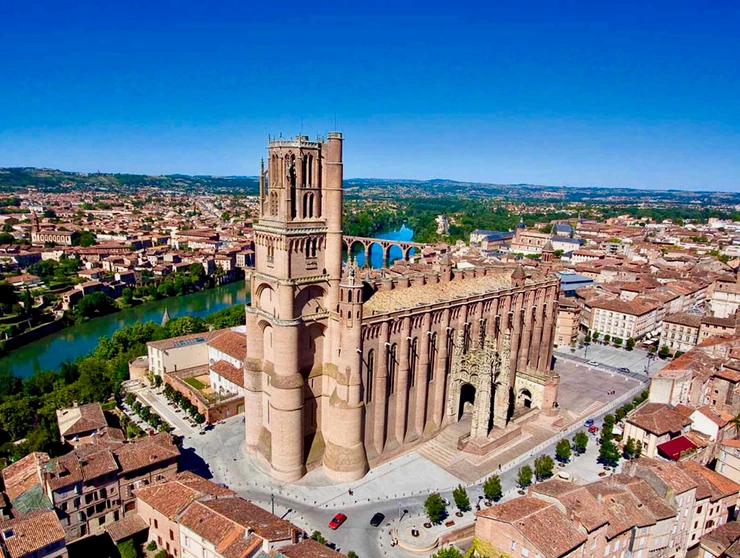
20. Albi Cathedral and the Berbie Palace, Albi
Albi is a serious town, with a weighty history, a wondrous must see destination in southwest France. Albi has two truly imposing citadels, the Albi Cathedral and the Berbie Palace, that are both UNESCO-listed sites in Europe.
The mighty Saint Cecilia Cathedral is a 13th century masterpiece of southern Gothic style. Nicknamed the “crucible of faith,” the cathedral appears more fortress than church. It’s one of the largest brick structures in the world. The cathedral has a stern unadorned exterior, but the interior is serenely blue and gold.
The 800 year old Berbie Palace is an all brick affair with stout walls of extraordinary height and thickness. Aside from the Pope’s Palace in Avignon, the Berbie Palace is one of the best preserved castles in France.
The palace was formerly the residence of the Albi’s archbishops. Now, it’s home to the Toulouse-Lautrec Museum, a world class single artist museum.
Here’s my complete guide to the underrated city of Albi and my guide to visiting the Toulouse-Lautrec Museum.

21. Chateau de Chambord, Loire Valley
The Chateau de Chambord is the big daddy of Loire valley chateaus, a must visit UNESCO site on a road trip in the Loire Valley. Building started on this massive Renaissance chateau in 1519.
Commissioned by Francois I, a lowly hunting lodge was transformed into a monument to royalty and royal sport. It’s rumored that Leonardo da Vinci, relocated from Milan to France as a court artist. He may have influenced some of the chateau’s architectural elements.
The chateau is laid out as a keep in the shape of a cross with four towers, two wings, and over 400 rooms. The highlight is its mind boggling double helix staircase.
Twin staircases intertwine without actually touching. The rooftop offers breathtaking views over the valley.
Here’s my guide to Chateau de Chambord. Click here to pre-book a skip the line ticket.

22. Louvre Museum, Paris
The Louvre is Paris’ crown jewel and the world’s most visited museum. The Louvre is the largest, busiest, most loved museum in the world. It’s part of the “Paris, Banks of the Seine” UNESCO designation.
It has 35,000 works of art art from the 6th century BC to the 19th century AD. It’s a sumptuous Renaissance palace itself, with a lavishly decorated interior and beautifully painted ceilings.
The Denon Wing is home to the Louvre’s best known paintings, including Leonardo da Vinci’s Mona Lisa. The Sully Wing is known for its statuary and antiquities, including the Venus de Milo. The Richelieu Wing houses the lavish apartments of Napoleon III and some famed Dutch art works, including Vermeer’s The Lacemaker.
If you want to know more about the history of the Louvre, click here. I’ve also written an extensive guide to the underrated masterpieces of the Louvre and one on tips and tricks for visiting the Louvre. You’ll need to book a timed entry ticket and/or guided tour.
READ: 3 Day Itinerary for Paris

23. Reims Cathedral, Champagne Region
With or without a glass of champagne, the Cathédrale Notre-Dame de Reims is one of Europe’s greatest UNESCO cathedrals. Some experts think it’s France’s most beautiful cathedral, surpassing even Notre Dame de Paris. Reims Cathedral was designated a UNESCO site in Europe in 1997.
The church was built over 60 years, beginning in 1211. The ornate western portal is distinctive for its beauty, unity, and harmony. Inside, there’s a towering 500 foot nave. You’re greeted by a wall of 52 intricately carved statues.
In the apse behind the ornate altar, you’ll see the catastrophically beautiful stained glass windows created by the famed French painter Marc Chagall in 1974.
Reims Cathedral is also the spot for the coronation of French kings, making it the equivalent of Westminster Abbey in England. Joan of Arc made an appearance, crowning Charles VII in 1429.
>>> Click here to book a Reims day trip from Paris.
READ: One Day In Reims Itinerary

24. Sainte-Chapelle, Paris
Completed in 1248 and enshrined within the Palais de Justice, Sainte-Chapelle is Paris’ most exquisite Gothic monument. It’s a 14th century royal chapel, built by Louis IX to house the relics of the passion of Christ, including the Crown of Thorns.
You’ll be awed by the gorgeous stained glass. Saint-Chapelle has some of the oldest pieces of glass in the world. Nearly 2/3 of the windows survived the French Revolution. To prevent further damage, the windows were temporarily removed during WWII.
Saint-Chapelle also features beautiful painted wood columns and a starry night sky. There are two parts to Saint-Chapelle.
The glass awaits you at the top of a spiral staircase, depicting scenes in chronological order from the Old and New Testaments. The masterpiece is the Rose Window in the upper chapel.
>>> Click here to book a skip the line ticket
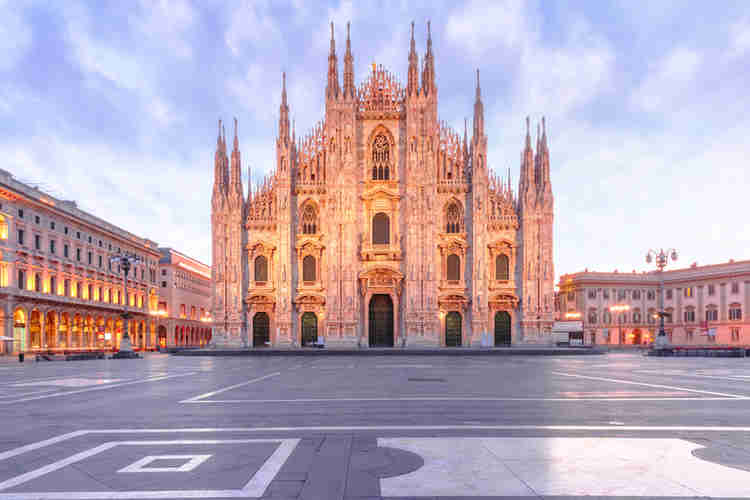
The Best UNESCO SitesIn Europe: Italy
25. Milan Cathedral, Milan
The Duomo is the symbol of Milan. It’s stood guard over Milan for 600 years.
Construction began in 1386, but wasn’t completed until the 19th century. Thanks to Milan’s ruler at the time, the Duomo was constructed with pink hued white marble from Lake Maggiore in northern Italy.
The Duomo is a vision of high Gothic architecture. It’s adorned with over 3,000 statues, 135 gargoyles, and 700 other figures. You can climb up to the terrace to examine them all in detail.
You can tour the Duomo, one of Milan’s must see sites, virtually on Google Arts & Culture here or on the Dumo website here.
You should pre-book a skip the line cathedral + rooftop ticket.
26. Hadrian’s Villa, Tivoli
Constructed between 118-133 A.D., Hadrian’s Villa is an important archeological complex just outside Rome. It’s the largest and most spectacular villa of ancient Rome, three times the size of Pompeii.
Hadrian’s Villa reflected the power and glory of ancient Rome and the world’s most important leader, Emperor Hadrian. And it was designed by Hadrian himself. The buildings were inspired by Greek, Roman, and Egyptian architecture.
Hadrian’s Villa is essentially a miniature Rome that covers nearly 300 acres. It’s dotted with 30 large structures — palaces, libraries, baths, living quarters, dining pavilions, and sculptural gardens.
The most beautiful spot is the Maritime Theater with an artificial island that was Hadrian’s private retreat.
I visited on this day trip from Rome and it was an excellent tour. It also included Villa d’Este, which I discuss next.

27. Villa d’Este, Tivoli
Villa d’Este is a sweet escape with sparkling fountains, moss draped grottos, and ponds filled with water lilies.
The late Renaissance UNESCO site in Europe is a playground of whimsy, topped with a frescoed villa and laden with sweet scent of honeysuckle.
Villa d’Este was the passion project of a cardinal who failed to become pope, Cardinal Ippolito d’Este. Ippolito decided to build a grandiose pleasure palace. He wanted a garden villa worthy of “one of the wealthiest ecclesiastics of the sixteenth century.”
And he got it. Inside, are breathtaking frescos and outside are gorgeous fountains. A highlight is the Organ Fountain, which plays organ music when the water spills down at 2:30 each day.

28. The Pantheon, Rome
Without a doubt, the Pantheon is the best preserved building from ancient Rome. You’d don’t have to wrinkle your brow or struggle to conceptualize anything, as with many ruins. It’s all before you.
The Pantheon was a temple dedicated to all of the gods. It’s one of Rome’s most beautiful churches.
The Pantheon was originally built by Augustus’ right hand man, Marcus Agrippa, in 27 BC. The pediment still proclaims that “Marcus Agrippa, three times consul made this.” But Agrippa’s version was destroyed by fire.
In 120 AD, the Pantheon was rebuilt by Hadrian. The well traveled emperor, a true Grecophile, reimagined it as an oversized Greek temple — with 40 foot tall Corinthian granite columns from Egypt, a pediment, and portico. It was considered a masterpiece of engineering and mathematical precision.
Here’s my complete guide to the Pantheon. The Pantheon is no longer free to visit. To avoid a long line, you’ll want to book a skip the line ticket.

29. The Colosseum, Rome
Formally named the Flavian Amphitheater, the Colosseum has stood in Rome for almost 2,000 years. It’s the most instantly recognizable monument from the classical world and is the #1 most visited UNESCO site in Europe.
Despite the ravages of time, the Colosseum is an incredibly well-preserved piece of Rome’s fascinating history. And it’s the most visited landmark in Italy.
Emperor Vespasian began constructing the Colosseum in 72 AD. It was finished by his son Titus in 80 AD.
Domitian subsequently added the hypogeum, or basement, where staging for the gladiator games took place. The hypogeum is only recently excavated and conserved. Here’s my guide to visiting the hypogeum.
In its glory days, the Colosseum was a vivid white with painted trim and frescoed hallways. There were monumental statues of the Greek and Roman gods in the arches of the middle two stories. The top story had a retractable canvas awning to shade spectators.
Here’s my complete guide to the Colosseum, with must know tips for visiting.
>>> Click here to book a skip the line ticket
30. The Roman Forum, Rome
The lovely rubble of the Roman Forum is a rectangular valley running from the Arch of Titus to the Capitoline Hill. The main road is the Via Sacre.
The forum was the beating heart of Rome, the seat of power, and its central showpiece. It was a grandiose district consisting of white temples, grand basilicas, and vibrant public spaces.
The Forum was the scene of political upheavals, funerals, and triumphant parades. Before the Colosseum was built, it even hosted gladiatorial battles.
You can visit the Basilica of Constantine, the Temple and House of the Vestal Virgins, the Temple of Venus and Rome, the Temple of Castor and Pollux, and the grave of Julius Caesar.
Here’s my complete guide to the Roman Forum. You can visit the forum with a three part ticket that also includes entry to the Colosseum and Palatine Hill.

31. Ruins of Pompeii, Pompeii Italy
The ruins of Pompeii are perhaps Italy’s most famous archaeological site. It’s the best example of a well-preserved ancient Roman city. Pompeii was destroyed by the eruption of Mount Vesuvius in 79.
The volcano buried the city under layers of volcanic ash. But that meant the site was preserved.
Though it was dubbed a “city of death,” Pompeii tells us more about the Romans’ daily life than any other UNESCO site in Europe. You can visit the temples, villas, forum, workshops, and even restaurants. You’ll be dazzled by the ancient restored frescos.
Moreover, there are things being excavated in Pompeii all the time. Right now, you can ogle the newly-restored frescoes in the House of the Vetii and the House of the Mysteries.
For more details, here’s my complete guide to Pompeii. To book a skip the line ticket, click here. I advise taking a guided tour with an archaeologist.
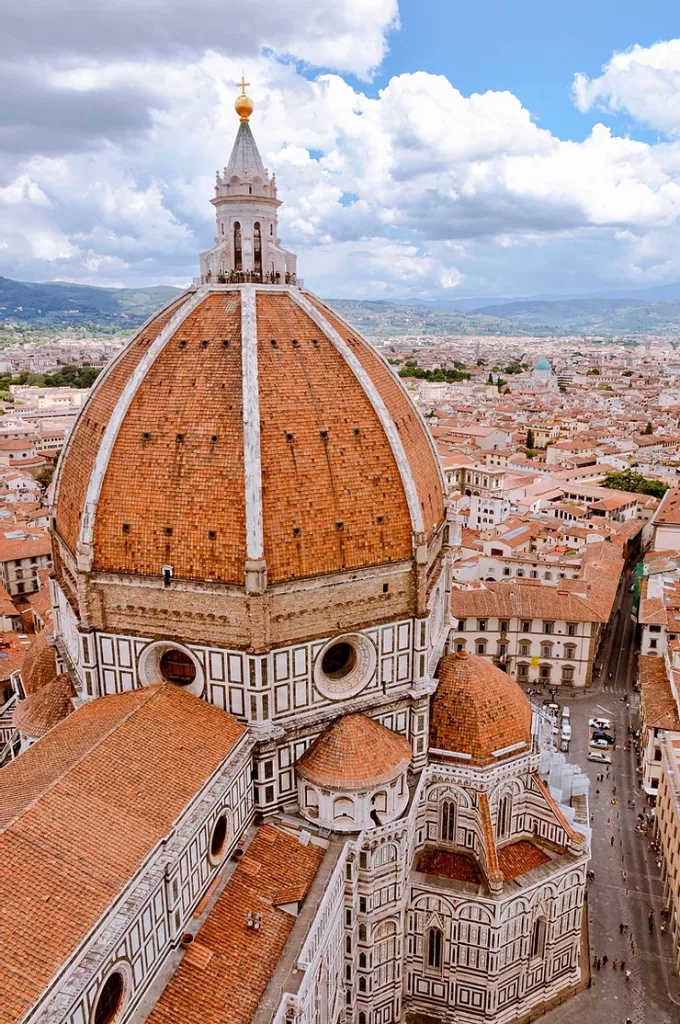
32. Duomo, Santa Maria del Fiore, Florence
The symbol of Florence is the Cathedral of Santa Maria del Fiore, nicknamed the Duomo.
Florence’s Duomo is Gothic in style, but not in the light and elegant way you think of Paris’ Notre Dame. It’s made of brown sandstone and beautifully faced with pink, green, and white marble.
Filippo Brunelleschi’s magnificent terra cotta colored dome, built from 1420-36, is the highlight.
It’s decorated with high Renaissance frescos by Giorgio Vasari, a Florentine artist and the world’s first art historian. For panoramic views, climb up Brunelleschi’s dome.
Here’s my guide to visiting the Duomo, with information on climbing the dome. Click here to book a ticket for the Duomo complex and the dome.

33. Field of Miracles, Pisa
The UNESCO-listed Field of Miracles in Pisa is a true spectacle — a simply splendid assemblage of Romanesque, Gothic, and Early Renaissance art and architecture. When you clap eyes on its marble sheathed buildings, you’ll likely gasp and conclude that it deserves the hype.
There are the six must see sites on the splendid square: the famous Leaning Tower, the Duomo, the Baptistery, the Monumental Cemetery, the Duomo Museum, and the Museum of the Sinopie.
Although a tourist-fly draw, the Leaning Tower is the least interesting of the monuments. The Duomo’s facade is decorated with alternating black and white marble stripes, quarried from Carrara. Inside, you’ll find a beautiful mosaic in the apse attributed to Cimabue and an ornate pulpit carved by Giovani Pisano.
The Baptistery is so ornate it appears to be dripping with lace. It houses another ornate pulpit carved by Nicola Pisano. The stunning Monumental Cemetery houses beautiful sculptures and important frescos.
For more information, here’s my one day in Pisa itinerary.
>>> Click here to book a skip the line ticket
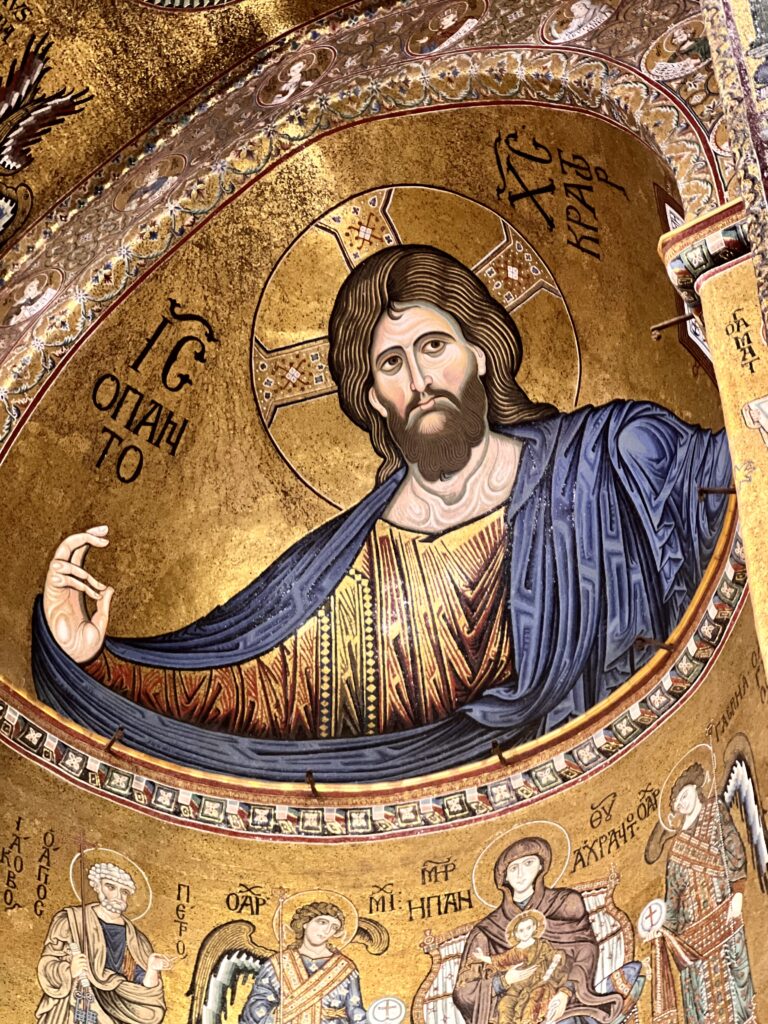
34. Monreale Cathedral, Sicily
Monreale Cathedral is the world’s most famous Arab-Norman cathedral with an astonishing 68,000 feet of glittering Byzantine mosaics set against 2 tons of gold leaf. It reminded me of St. Mark’s Cathedral.
The cathedral was founded in the 12th century by William II and you’ll see his portrait and tomb. The fortress-like facade has two square corner towers flanking the great marble portal. Be sure to walk around the back where you can see the Moorish decorations.
The mosaics depict a host of episodes and an endless cast of characters from the story of Genesis. The highlight, in the apse, is a mosaic of Christ Pantocrater. It’s the largest one in Europe. It shows a long haired Christ in glory raising his hand in a two fingered Byzantine-style blessing.
You’ll also be dazzled by the Byzantine-style floors, Corinthian columns, and an intricate carved wood ceiling. The cloisters are also beautiful and the best preserved one of its type in Sicily.
To get the full scoop on Monreale Cathedral, you can book a guided tour from an expert or visit on a half day guided tour from Palermo
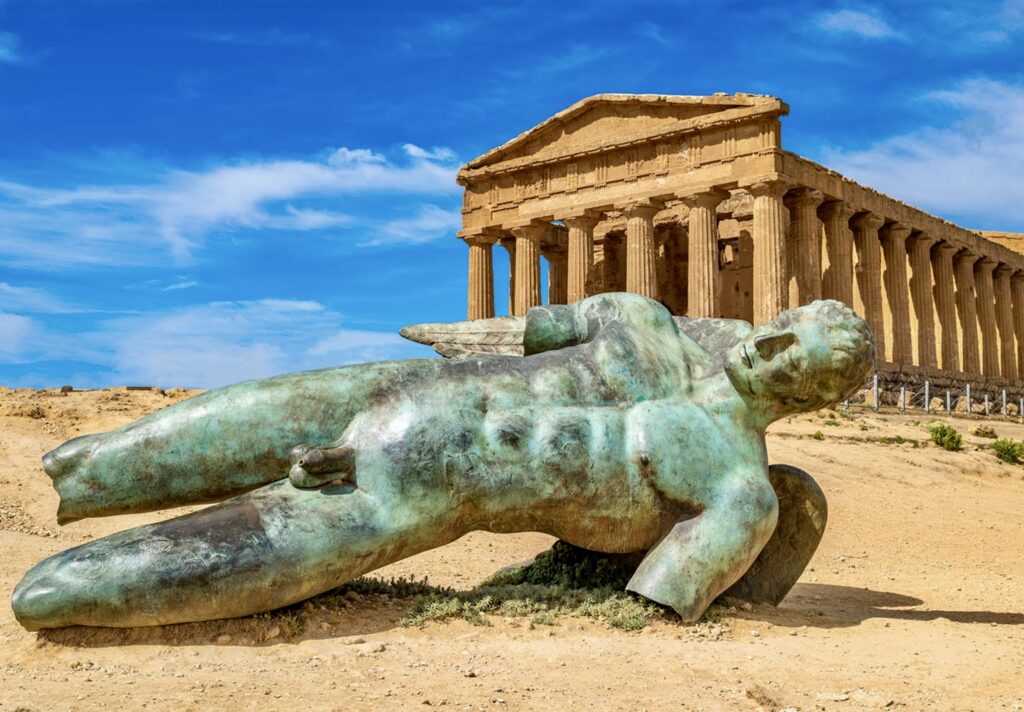
35. Valley of the Temples, Sicily
The Valley of the Temples is the world’s largest archaeological site and Sicily’s star attraction. Lying on the island’s southern coast, the complex is chock full of spectacular Greek ruins.
In 1997, the Valley of the Temples became a designated UNESCO site in Europe. It’s an ancient wonder that has attracted travelers throughout history. Indeed, some say the best preserved Greek ruins are found, not in Greece, but in Sicily.
The temples were once shiny and new, showcasing the power of the Greek culture and ancient Agrigento. Today, some lie in romantic ruins among olive groves while others are in pristine condition.
Pure in line and logic, these honey-colored Doric temples boast a stunning setting in a rolling valley ridge. You can’t help but be transported back to the 6th century B.C. You can scamper over their steps, sit amid the ruins, and gaze out onto the sea.
Here’s my guide to visiting the Agrigento’s Valley of the Temples. In high season, you should pre-book a skip the line ticket to avoid lines. You can alsobook a guided tour from Catania or a guided tour from Palermo.
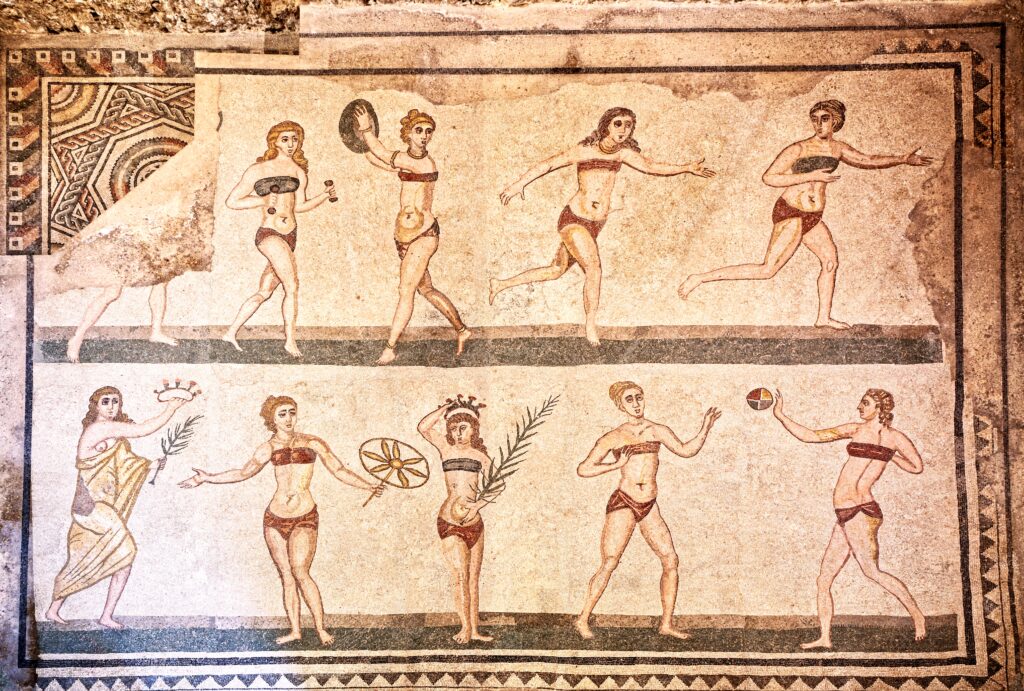
36. Villa Romana del Casale, Sicily
The UNESCO-listed Villa Romana del Casale in Sicily. It’s an incredibly mosaicked country villa built by Roman aristocrats in the 4th century.
Villa Romana del Casale has the world’s largest collection of in situ Roman mosaics — 3,700 square feet.
They’re well-preserved and truly incredible, some of the most whimsical and detailed mosaics from the ancient world I’ve seen.
The time capsule villa gives you an “up close and personal” look at just how extravagantly aristocratic Romans once lived. You can almost imagine the big shots, clad in togas, heading off to discuss politics in the board room.
Here’s my complete guide to the villa mosaics.
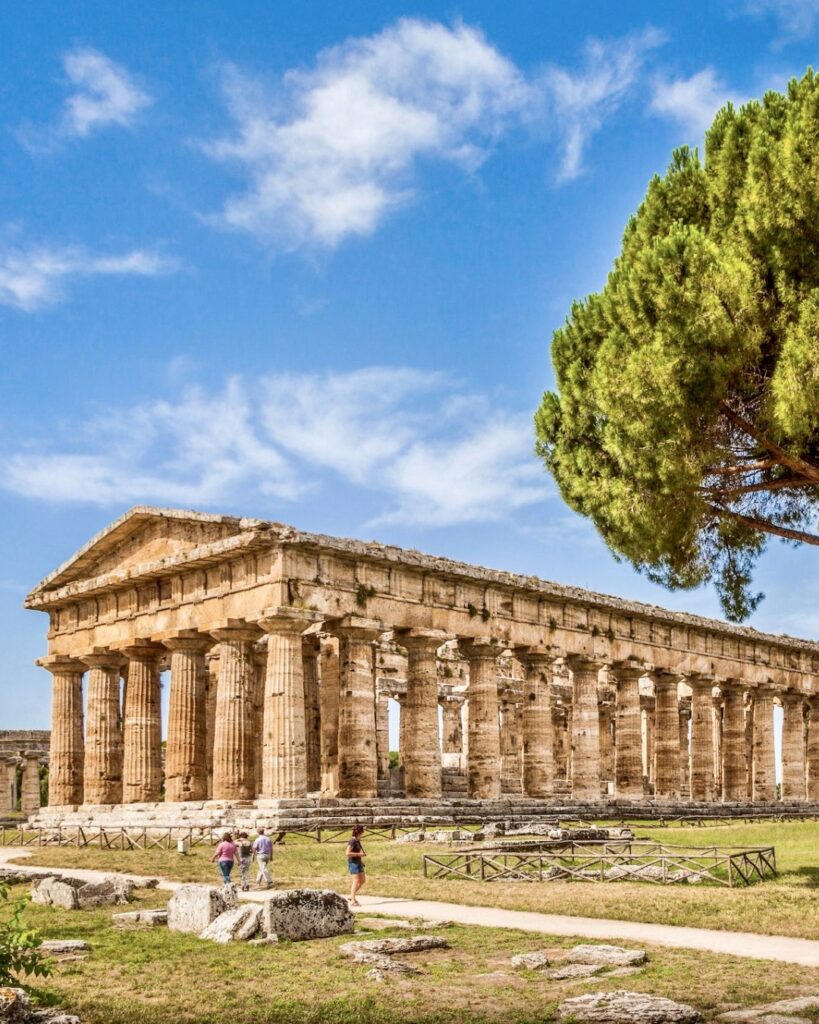
37. Greek Temples In Paestum, Italy
Nestled just south of the renowned Amalfi Coast, the town of Paestum stands as a vivid testament to Italy’s rich ancient history. This UNESCO-listed gem holds a treasury of awe-inspiring Greek archaeological marvels, unrivaled on the Italian mainland.
Once a vital part of Magna Graecia, or Greater Greece, Paestum proudly displays three exquisitely preserved Doric temples that trace back to 650 to 450 BC.
The onsite Paestum Archaeological Museum is a great starting point to grasp the significance of the temples. This contemporary museum houses archaeological treasures unearthed over centuries of excavation at the Paestum site.
Inside, you’ll encounter a captivating array of artifacts, including Greek statues, terracotta pieces, Neolithic, Bronze, and Iron Age pottery, coins, jewelry, and tomb paintings. The most famous piece is the Tomb of the Diver, the only known figurative Greek painting from the era.
If you are a history buff, you may want to book a guided tour with an archaeologist or a 2 hour private tour.

The Best UNESCO Sites In Europe: Portugal
38. Jeronimos Monastery, Belem
Jeronimos Monastery is a 500 year old UNESCO site in Europe. It should definitely be on your itinerary for Lisbon.
It’s the premiere example of Manueline architecture in Portugal and the #1 site in Lisbon’s Belem district. It’s a distinctively Portuguese style, named after its key influencer, King Manuel I, who reigned from 1495 to 1521.
The highlight of the monastery is its two level cloister — honey colored and dripping with organic detail.
You’ll be wowed by the delicately scalloped arches, twisting turrets, and columns intertwined with leaves, vines, and knots. And the gargoyles and beasties on the upper facade.
To avoid a long wait in line, you should book a skip the line ticket.
39. The Palaces of Sintra, Sintra
Sintra is one of the most popular day trips from Lisbon, only 30 minutes away.
Sintra is a rock star gorgeous, with numerous UNESCO castles and palaces. It’s dazzling, colorful, and romantic. Even the town itself is quaint.
Most people adore Pena Palace, with its funky pastiche of architecture with Ronald McDonald colors.
I love the bewitching Quinta da Regaleira, an extravagant stony Gothic affair with follies and a mysterious Masonic initiation well. The Castle of the Moors and Sintra National Palace are also UNESCO-listed.
Here’s my complete guide to visiting Pena Palace. The palace is so popular that you’ll need to book a skip the line ticket in advance.
40. Alcobaca Monastery, Alcobaca
If you love history or architecture, the UNESCO-listed Alcobaça Monastery is a must see visit in Portugal.
The austere and atmospheric building is 800 year old and the largest Gothic religious structure in Portugal. It’s one of Europe’s oldest and best UNESCO sites.
Alcobaça is a 12th century masterpiece of Gothic Cistercian art. Its vaunted architecture and history are bewitching.
Inside, you’ll fine the ornate tombs of King Pedro I and Ines de Castro, Portugal’s famous star crossed lovers. I was so besotted with their story, that I wrote a separate blog post about them.

41. Coimbra University, Coimbra
The atmospheric town of Coimbra is known as the “Athens of Portugal.” The star of Coimbra is its UNESCO-listed Coimbra University.
Perched on the town’s hilltop, it’s one of the oldest universities in the world, older than Oxford University. It boasts some of the most ornate, richly decorated buildings of any university.
Highlights are the Royal Palace, the Hall of Great Acts, the Private Exam Room, and the glorious Baroque Joanina Library. If you’re there in person, you can climb the 18th century bell tower for panoramic views.
You can take a virtual tour of Coimbra University here. If you’ll be visiting Coimbra, you can check out my one day in Coimbra itinerary.
>>> Click here to book a walking tour of Coimbra University
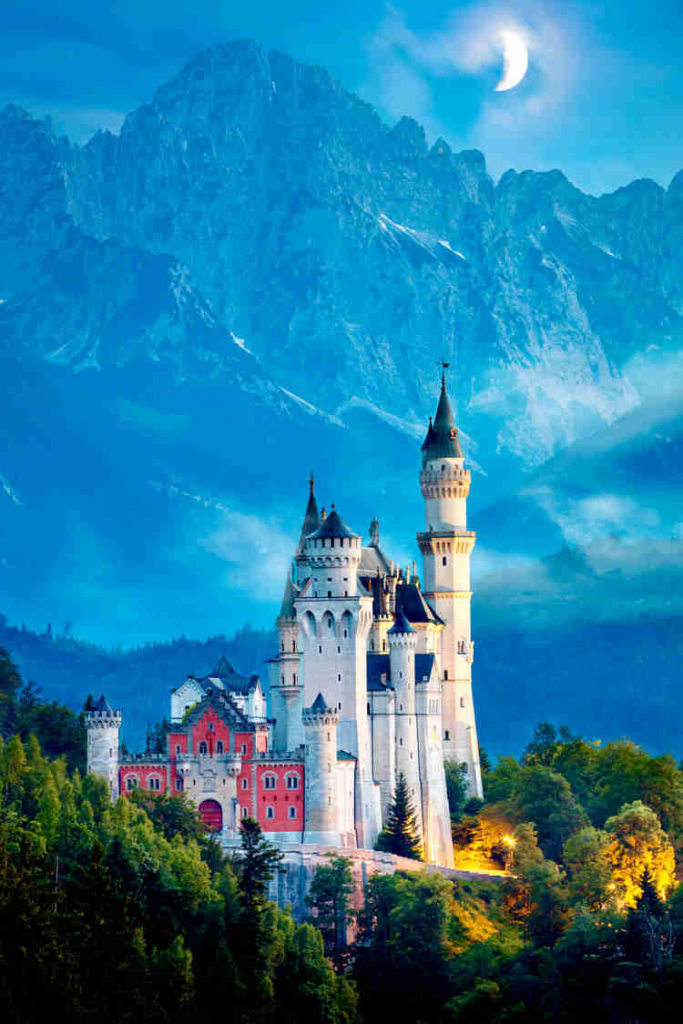
The Best UNESCO Sites In Europe: Germany
42. The Palaces of Mad King Ludwig of Bavaria
In the 19th century, King Ludwig II of Bavaria was one of Europe’s most famous and flamboyant royals. He built some of Bavaria’s most fairytale-like castles and palaces.
He was variously known as the Swan King, the Dream King, the Night King, the Moon King, and the Fairytale King. I’ve written at length about my fascination with him and his tragic fate.
Ludwig was born in the beautiful Nymphenburg Palace, right outside of Munich. He grew up in Hohenschwangau Palace and lived in the Munich Residence.
He built some of Germany’s most popular attractions. Three of them are UNESCO sites — Neuschwanstein Castle, Linderhof Palace, and Herrenchiemsee Palace.
If you want more info, here’s my complete guide to visiting Neuschwanstein Castle. You’ll want to purchase a skip the line ticket or visit on a guided day trip from Munich.

43. The Wurzberg Residence
The Wurzburg Residence is such a glamorous palace that it’s been dubbed the “German Versailles.” It’s a much more enjoyable tourist experience than its nick-namesake, the French Versailles.
Compared to Louis XIV’s over-touristed digs, the Wurzburg Residence — one of Europe’s most important Baroque palaces — is incredibly enjoyable.
The Wurzburg Residence is the former home of the Wurzburg bishop-princes, the elected rulers of the Holy Roman Empire. These princes had both secular and religious authority. In 1720, prince-bishop Johann Philipp Franz von Schönborn commissioned the residence.
He aimed to create an eye popping spectacle, something akin to the grandeur of Versailles. And he succeeded. The highlights are the world famous staircase, frescos by Tiepolo, and the stunning White Hall.
Here’s my complete guide to visiting the Wurzburg Residence, the first stop of Germany’s Romantic Road.

44. The UNESCO Town of Bamberg
With crooked half timber houses, picturesque canals, and an elegant palace, Bamberg is an underrated gem in northern Bavaria.
Dubbed the “city of seven hills,” Bamberg brims with authentic charm, medieval architecture, and fairytale vibes. In 1993, its Alstadt, or old town, was declared a UNESCO site.
Bamberg is home to some appealing curiosities — smoke beer, stuffed onions, the mysterious Bamberg Horseman, and it’s own “Little Venice.”
If you’re on a road trip in Bavaria, Bamberg is a fantastic stop or detour, especially if you’re a history lover or beer nerd. It’s most famous site is the stunning town hall, which floats above the River Regnitz.
>>> Click here to book a Bamberg walking tour
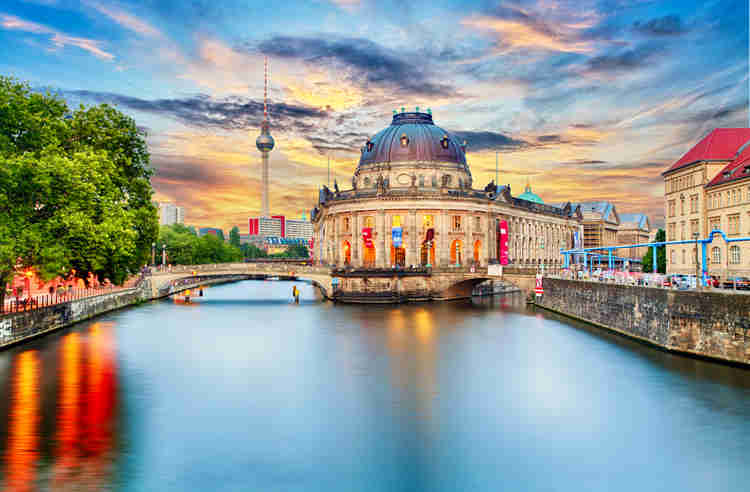
45. Museum Island, Berlin
Berlin’s Museum Island is a veritable treasure trove. It houses a complex of buildings above the Spree River.
There are five beautifully restored museums, which you can visit on Google Arts & Culture — the Pergamon Museum, the Bode Museum, the Neues Museum, the Alte National Gallery, and the Altes Museum.
The art work and artifacts on Museum Island span 6,000 years. They include Greek, Etruscan, Roman, and medieval antiquities.
The star attraction is the beautiful Pergamon Museum, which houses the Ishar Gate from Babylon.
>>> Click here to book a ticket to the Pergamon Museum

46. Cologne Cathedral, Cologne
A hallmark of the Rhine River, Cologne Cathedral is one of Germany’s most stunning UNESCO sites and its most visited attraction.
Finished in 1880, the stone mass is almost 160 meters high. It was constructed in a Flamboyant Gothic style, which reflected the Romantic Movement prevalent at the time.
Inside, there’s the Shrine of the Three Wise men with the relics of three kings. The relics make the cathedral an important place of pilgrimage.
There’s also gorgeous stained glass, including a newer piece by famed German artist Gerard Richter. It’s a bit of a miracle that the cathedral escaped WWII with only some damage.

The Best UNESCO Sites In Europe: Croatia
47. St. James Cathedral, Sibenik
Sibenik Cathedral is the most important piece of Renaissance architecture in Croatia. It sits in what was Sibenik’s most important square in medieval times.
The cathedral is famous for being built with stone quarried from the Dalmatian islands. It’s reputed to be the world’s largest church built completely of stone, without brick or wooden supports.
The cathedral’s most notable element is its intricate stone frieze and decorative detailing that adorn its facade.
The most prominent part of the exterior is the frieze of 71 sculpted faces, known as “the Façade of the Friars.” These portraits represent the citizens of Šibenik from the time.
READ: 10 Days in Croatia Itinerary

48. Diocletian’s Palace, Split
With a fetching location on the dramatic Split harbor, Diocletian’s Palace is Split’s #1 attraction. It’s one of the most imposing ancient Roman structures in existence today.
It’s not just a standalone palace, or a museum, or a UNESCO site in Europe. It’s the living, breathing, vibrant heart of the town of Split.
The 4th century complex is a sprawling maze of beautifully preserved ancient ruins, shops, restaurants, apartments, and people.
Highlights include the Peristyle Square with its colonnades, the Emperor’s Mausoleum transformed into St. Domnius Cathedral, the impressive Golden Gate, and the intriguing basements that were a filming location for the TV series Game of Thrones.
Here’s my complete guide to visiting Diocletian’s Palace. Click here to book a tour of the palace.
49. Historic Town of Trogir
I fell hard for the storybook UNESCO village of Trogir, known as Croatia’s “stone beauty.” Trogir is on the Dalmatian Coast of Croatia.
It’s secluded on a tiny island and encircled with medieval walls. It felt like the tiny town consisted solely of limestone and tangled alleyways, and sprinkled with fairy dust.
All you need to do is stroll the medieval streets and find a quaint nook to dine in. For a view of the pretty town, climb either Kamerlengo Fortress or the tower of St. Lawrence Cathedral. Or both.

The Best UNESCO Sites In Europe: Austria
50. Belvedere Palace, Vienna
The Belvedere Palace is an important UNESCO site in Europe for its showy architectural ensemble. The Belvedere is also one of Europe’s most important museums. So if you’ll only make one “art stop” in Vienna, this is the place to choose.
The Belvedere’s a haven of Baroque and Austrian art from the 19th and 20th centuries.
Its main claim to fame is the world’s largest collection of Gustav Klimt paintings, including the world famous The Kiss. It also boasts masterworks by Egon Schiele and Oskar Kokoschka, two important Expressionist painters.
Here’s my complete guide to visiting the Belvedere Palace. Click here to book a skip the line ticket.
READ: Guide To the Best Museums in Vienna

51. Schönbrunn Palace, Vienna
Schönbrunn Palace is Vienna’s #1 attraction and a UNESCO-listed site in Europe since 1996.
The swishy Renaissance palace was the summer home of the Hapsburg dynasty, the family that ruled the Austro-Hungarian empire for nearly 650 years. You’ll want to check out the palace itself and the extensive garden complex.
Of Schönbrunn’s 1441 rooms, 40 are open to the public via audio guide or guided tour. The “Imperial Tour” takes you into 22 rooms, including the imperial apartments of Emperor Franz Joseph and famous wife, Empress Sisi. Sisi has her own museum in Vienna. And don’t miss the Mirror Room, where Mozart gave his first concert at age 6.
You can book a guided tour of the palace, attend an evening concert, or visit the Christmas Market.
READ: 3 Day Itinerary for Vienna
52. Melk Abbey, Melk
Beaming like a golden halo over the Wachau Valley stands Austria’s prettiest church: Melk Abbey. It’s a must visit attraction in Austria, especially if you’re on the UNESCO trail. Its elegant yellow buildings form one of the most important landmarks and religious complexes in Europe.
Melk Abbey is an incredible building, both inside and out. Marble, frescos, spiraling staircases, stately royal rooms, and gilt — oh my! It fulfills the promise of Baroque design to “overwhelm the viewer.”
But not in an overly gaudy way that the Baroque style sometimes can. And not in a sometimes boring way that the Hapsburgs palaces can. It charms with yellow, pink, and gold sweetbox tones.
Here’s my guide to Melk Abbey and my guide to the Wachau Valley. Click here to book a guided day trip from Vienna.
53. St. Stephen’s Cathedral, Vienna
The towering St. Stephens Cathedral is Vienna’s defining landmark. You can’t miss it. Its most distinctive feature is its multicolor tiled roof, which looks glorious in the sunshine.
Both towers of the cathedral are open to the public and can be climbed for a fee. The south tower is the highest and affords the best views of the city (and the exquisite roof).
The interior of St. Stephens is not as eye catching as the exterior to my mind, rather gloomy. But its three nave design is nonetheless impressive to behold.
You can explore St. Stephen’s Cathedral here on the official website.

UNESCO Sites In Europe: Russia
54. Winter Palace, St. Petersburg Russia
The Winter Palace was the official home of the Russian imperial family until the Russian Revolution in 1917. Commissioned by Empress Anna, construction of this monolith began in 1732.
When Catherine the Great took the throne in 1762, she completely redid the interiors. The palace continued to be embellished through the 19th century.
Today, the Winter Palace houses the State Hermitage, one of the world’s truly impressive museums. It’s the second largest museum in the world with a slew of masterpieces.
You can explore its artsy endless halls with the Google Art Project guide or explore the palace on Google Arts & Culture. Alternatively, check out the Hermitage website, which boasts a large digital archive with very convenient navigation.

UNESCO Sites In Europe: Greece
55. The Acropolis
Greece has 18 UNESCO sites. I’m going to focus on the best one, the Acropolis in Athens.
The Acropolis is the most magnificent ancient Greek monumental complex in existence. It includes the Parthenon, the Erechtheion, the Propylaia, and the Temple of Athena Nike.
The Parthenon was built between 447 B.C. and 432 B.C. and was the center of religious life. It was decorated with the finest art of its day, conceived and carved by master sculptor Phidias. The east and west pediments had magnificent friezes depicting a continuous narrative of the Athenian gods.
The friezes were mostly pilfered. Some, dubbed the Elgin Marbles, are in the British Museum in London. Others are in the Acropolis Museum in Athens.
READ: One Day In Athens Itinerary
I hope you’ve enjoyed my guide to best UNESCO sites in Europe. You may enjoy these other Europe travel guides and resources:
- 12 one week in Italy itineraries
- 8 one week in Central Europe itineraries
- 10 day itinerary for southern France
- 6 one week itineraries for Spain
- Prettiest towns in Germany
- Prettiest towns in Italy
- 10 day itinerary for Italy
- Secret towns in France
- Secret Towns in Spain
- Prettiest towns in Andalusia
If you’d like to visit amazing UNESCO sites in Europe, pin it for later.

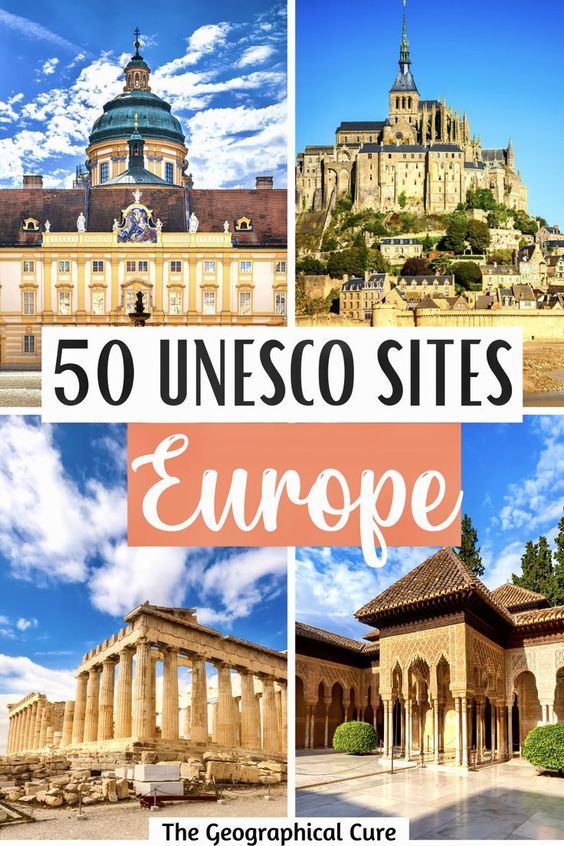
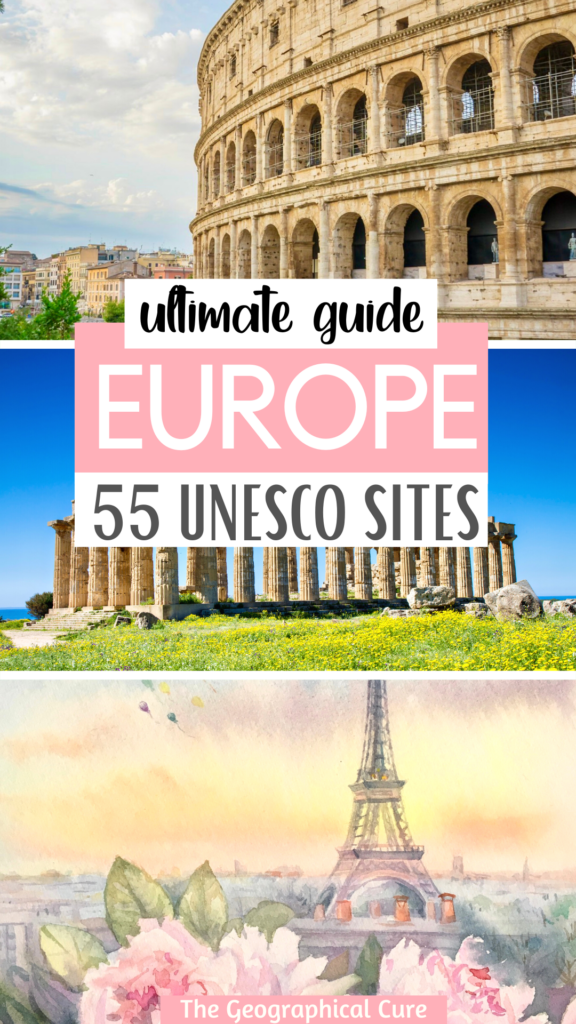
Your guides are marvelous – eye candy, lots of history, enchanting photos, you give it your all. Thank you!
Thank you so much!
The article skillfully highlights the significance of these sites as custodians of humanity’s collective heritage, emphasizing their role in preserving and celebrating the diverse cultural traditions and achievements of past civilizations.